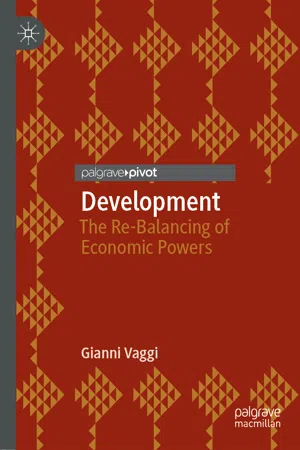Once upon a time, there was economic growth. Development was largely understood as being economic development, which was economic growth, and mainly defined in terms of the increases in income per capita , Y/L, that is, the ratio of the Gross Domestic Product , GDP = Y, to population L. Economic growth would overcome poverty, which is identified as a low-income per capita .
With no pretence of comprehensiveness, this chapter presents some of the most relevant growth models since World War II. These models are not all unanimous in their analysis of the process of economic growth, and they imply different policy recommendations. With great simplification, we can classify growth theories into two broad groups: the mainstream one, which largely adopts the assumption of neoclassical economics , and the heterodox approaches , which highlight the role of social and economic structures . Section 1.2 deals with the first group while Sects. 1.3 and 1.4 describe the alternative views. The final section will focus on market efficiency.
1.1 Harrod: When the Economic Cycle Becomes a Growth Theory
Modern theories of economic growth originate as an answer to two major historical events. First, the great depression of 1929–1932, which was followed by Roosevelt’s New Deal . The central issue concerns the conditions which determine the level of output and employment. The second event is the reconstruction of the economies of Western Europe and Japan after World War II, which had a very important impact on the growth models of the forties and fifties.
A 1939 paper by Roy Harrod can be regarded as the starting point of the theories of economic growth (Harrod 1939). Seven years later, an American economist, Evsey Domar, independently arrived at very similar conclusions, and quite often we hear of the Harrod-Domar growth model (Domar 1946). The most influential contribution to modelling economic growth is Robert Solow’s 1956 paper (Solow 1956), which has led to several misunderstandings about Harrod’s contribution, including ascribing to him a notion of equilibrium which was developed by Solow .1
Harrod is not concerned with long-run growth but with the trade cycle , and in particular, with the low phase of the cycle and the impact this has on employment, along Keynesian lines (Harrod 1939: 16).2 The focus on the stock of capital as the main constraint in the determination of income growth is quite understandable in the historical conditions of the late thirties.3
Harrod does not explicitly mention a
production function but makes some assumptions:
- A1.
Technology is characterized by a fixed ratio of capital to output: the capital–output ratio C, K/Y, where ‘C stands for the value of the capital goods required for the production of a unit increment of output’ (Harrod 1939: 16)4;
- A2.
Capital goods last forever, as there is no wear and tear;
- A3.
The output Y can either be used for consumption, or it can be saved and invested;
- A4.
s is the propensity to save , call it the saving ratio ; that is, total savings S divided by total output, s = S/Y; s is given and constant;
G is the
growth rate of output, ΔY/Y. With a fixed
C, economic growth depends on the amount of new capital available, ΔK; that is, net
investments , I = ΔK. If ex-ante investments are equal to the available savings, then I = S, in which
case Harrod derives what he calls the ‘fundamental equation’:
Gw is the warranted rate of growth : that is, ‘that rate of growth which, if it occurs, will leave all parties satisfied that they have produced neither more nor less than the right amount’ (ibid.: 16). However, in general the actual growth rate G is not equal to Gw, and, above all, there is no built-in market tendency for the actual growth rate to move towards the warranted one (ibid.: 30).
The actual growth rate G depends on four ‘fundamental conditions’ (ibid.): long-run capital expenditures; the capital coefficient, ΔY/ΔK; the propensity to consume and the current account balance. Each amount has a stimulating effect on economic growth (ibid.).
Apart from the second condition, which is concerned with technology , the other three refer to the typical Keynesian components of aggregate demand in an open economy: consumption, investments and net exports . Aggregate demand plays an essential role in the determination of the actual growth rate of the economy.
However, Eq. (1.1) is often used as a supply-side model of long-run growth ; this misinterpretation of Harrod’s contribution depends on the fact that Eq. (1.1) is considered as if it referred to the actual growth rate and not to the warranted one. The misreading of Harrod’s contribution is due to the failure to appreciate the fact that he adopts the Keynesian distinction between ex-ante and ex-post investments (Harrod 1939: 19). The former are investments as they are planned by business people, while the latter are investments which include inventories from unsold output; investments are equal to overall savings just as in the case of an accounting identity.
This misinterpretation of Harrod’s contribution removes the role of demand in the determination of economic growth and misses what he feels are the reasons the actual growth rate can permanently diverge from the warranted one.
Halsmayer and Hoover remind us of ‘Harrod’s major longer-term concern with the constitutional tendency of the economy to slip into recession when saving rates were relatively high’ (Halsmayer and Hoover 2016: 587), a point on which we will come back in Sect. 3.4 below. In the final pages of the paper, Harrod discusses the role of active policies (Harrod 1939: 31–33). Harrod indicates that a low rate of interest might have a ‘depressing influence’ on savings (ibid.: 32).5 However,...

